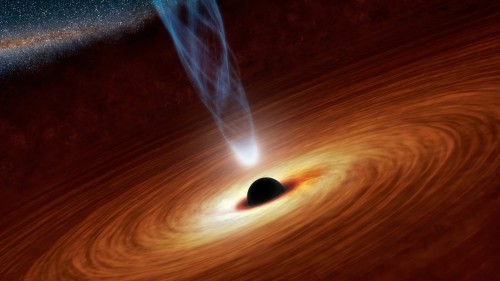The other winners are Reinhart Ganzel and Andrea Gaz. Gaz is the fourth woman overall to win the Nobel Prize in Physics over the 120 years the prize has been awarded

The Nobel Prize in Physics for 2020 was awarded to three researchers:
Half of the prize was awarded to Roger Penrose for the discovery that the formation of black holes is a prediction of general relativity; The second half was awarded to Reinhard Ganzel and Andrea Gas for the discovery of compressed superheavy objects - the black hole at the center of the Milky Way galaxy.
Black holes and the darkest secret of the Milky Way
Three scientists are the winners of the 2020 Nobel Prize in Physics thanks to their discoveries regarding the most mysterious phenomenon in the universe, black holes. Roger Penrose showed that general relativity leads to the formation of black holes. Reinhard Ganzel and Andrea Gass discovered that an invisible and extremely heavy object controls the orbits of the stars at the center of our galaxy. A supermassive black hole is the only currently known explanation for this phenomenon.
Roger Penrose used ingenious mathematical methods in his proof that black holes are a direct result of Albert Einstein's theory of general relativity. Einstein himself did not believe that black holes actually exist, those monstrous objects with their weight that capture everything that approaches them. Nothing can escape them, not even the light.
In January 1965, ten years after Einstein's death, Roger Penrose proved that black holes can indeed be formed and described them in detail; In their essence, black holes hide within them a singularity, a point where all our known laws of nature stop working. His groundbreaking paper is still considered the most important contribution to general relativity since Einstein.
Reinhard Ganzel and Andrea Gass led, each and every one of them separately, a group of astronomers who, since the early 16s, focused on a region in space called the A* arc in the center of our galaxy (from Wikipedia: the location from which a particularly strong and concentrated radio transmission originates in the center of the Milky Way galaxy due to a black hole located there On October 2002, 2, an international team led by Rainer Schodel from the Max Planck Institute reported for the first time an observation in which they followed the movement of the star SXNUMX, which is located near Sagittarius A* for nearly ten years). The orbits of the brightest stars near the center of the Milky Way have been mapped with ever-improving accuracy over the years. The measurements obtained in the studies of these two research groups led to the agreement that there is an extremely heavy, invisible object that attracts and distorts the normal orbits of the stars, causing them to move at enormous speeds. Their measurements showed that this object is comparable in mass to four million suns and is still compressed into an area no larger than our solar system. Using the largest telescopes currently available to mankind, the two researchers developed methods to view the center of the Milky Way galaxy, through vast clouds of gas and interstellar dust. Pushing the limits of human technology, these two researchers developed new methods while compensating for the disturbances caused by the Earth's atmosphere, while building unique instruments and making a personal commitment to long-term research. Their pioneering work provided us with the strongest evidence yet for the existence of black holes at the center of the Milky Way galaxy.
"The discoveries of this year's Nobel Prize winners broke new paths in the study of dense and superheavy objects. However, these mysterious objects still hold many questions begging for answers, questions that encourage further research. Not only questions regarding the internal structure of such objects, but also questions regarding the examination of our theory regarding gravity under extreme conditions in the direct vicinity of a black hole", says David Hoyland, Chairman of the Prize Committee in Physics.
BREAKING NEWS:
- The Nobel Prize (@NobelPrize) October 6, 2020
The Royal Swedish Academy of Sciences has decided to award the 2020 #NobelPrize in Physics with one half to Roger Penrose and the other half jointly to Reinhard Genzel and Andrea Ghez. pic.twitter.com/MipWwFtMjz

11 תגובות
To Meir the fool.
The fact that there are Jewish winners means nothing about you. The fact that you are looking for a woman and an unknown relationship with them only shows how miserable you are.
Reminds me of the one who, while working on the roots at the age of 13, he and his parents were proud that they were a scion of Rambam. But, to put it mildly, it was not the most moist wipe in the package...
proofreading!
Father, what about recent comments?
What substance to take?
People here have a stela all over their heads
It is recommended to watch the movie about black holes on Netflix. A fairly recent film from 2019 in which these amazing discoveries appear accompanied by impressive graphics
And all the families of the earth will be blessed in you. The blessing that the Holy One, blessed be He, blessed Abraham and passed on to Jacob our father. Most of the significant winners are Jewish.
When will the last comments be returned?
Now we know.
And why, in the writer's opinion, is it not important to say that Penrose is of Jewish origin?
And also Andrea Gaz, according to Wikipedia.
And the two basic concepts in writing spontaneous responses are unnecessary time and access to a keyboard.
The structure of the universe is completely different from what is known today
A wonderful new universe exists in reality, but it is not directly observable.
The two fundamental concepts in the Newtonian universe are force and matter
The two fundamental concepts in the Einsteinian universe are energy and matter
The two fundamental concepts in the neural universe are energy and passive time.
http://img2.timg.co.il/forums/2/7512af65-e1e5-47ac-af36-b3654d2d790b.pdf
A. Asbar